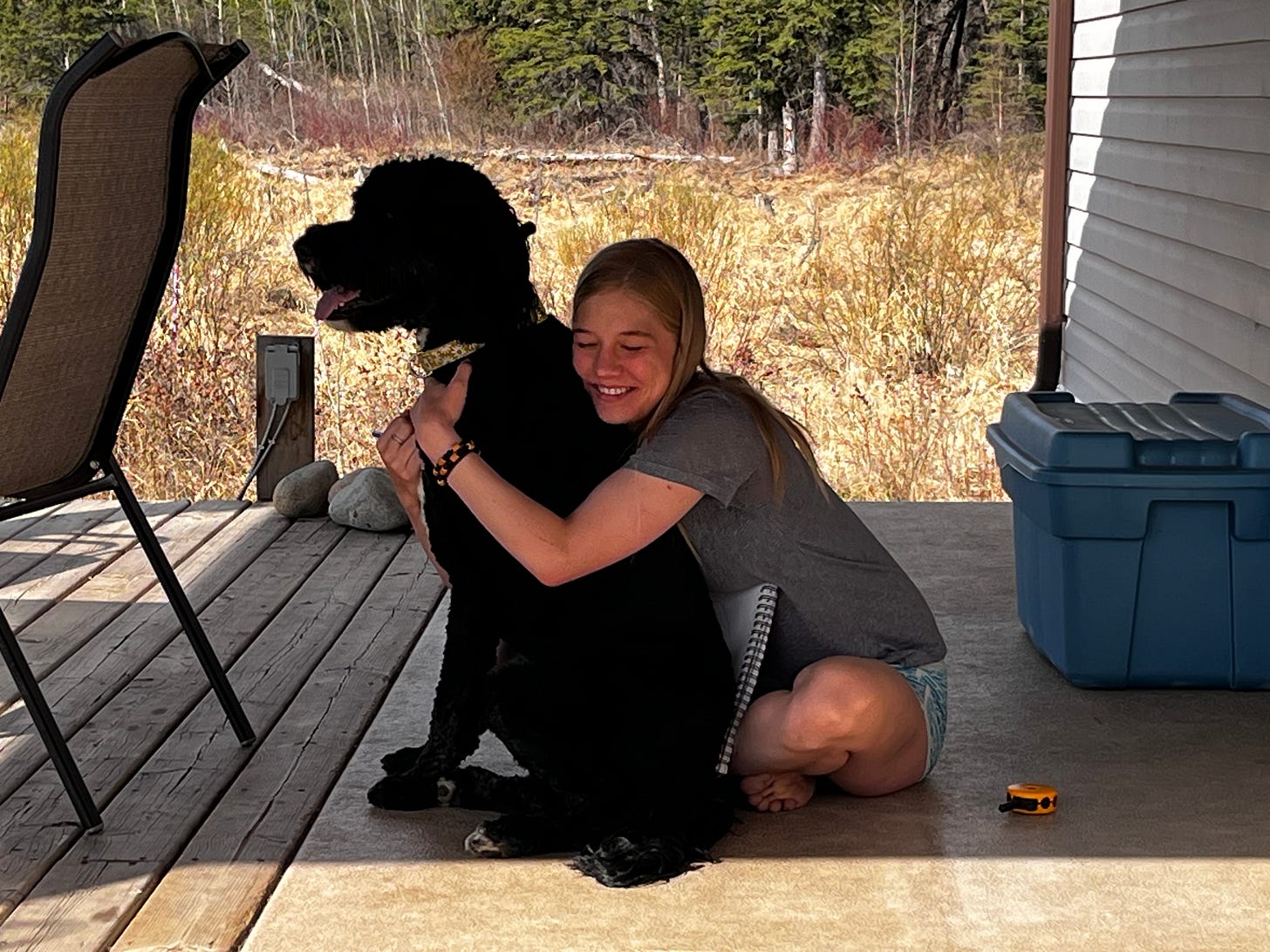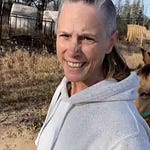This post is about a 7 minute read. The video above is a relaxing 16 minute one, though!
And a note: I’m not Joy’s trainer, or her primary handler. I know there are some cringe-y moments for those two individuals in this video. Dog training (and in this case service dog training) is a very, very rich topic and I hope to do a lot more work in that area (with help!). However, this post is about something quite different, and is coming from my OT brain and heart. My body is doing the work as best she can!
Sometimes our behaviour is what we call “bad.” When that happens, it is tempting to assume that punishment, and its resultant associations, will curb future “bad” behaviour. That story plays out over and over and over, and it rarely works. I think the few times it does sort of fuel our addiction to reacting, rather than setting ourselves, our loved ones, and our animals, up for success in the first place. Helping another being to “organize,” in other words, as opposed to simply applying consequences, is an option, and I think a really good one.
I think this concept (organizing vs “discipline”) will probably lead to a few more posts, because the ideas surrounding shifting our approach to “bad behaviour” are really rich. For me, personally.
The easiest behaviours to label are, of course, the most obviously antisocial ones - acting out, lashing out, aggression, withdrawal, and on and on. In people, these behaviours usually lead to labels, more “supports” (which may or may not be in support of that person - more often they are in support of the context that person is endangering), and then, quite often, some means of separation between that person and others, who are in circle of “potential for harm.” Once separation has happened, it is quite easy for a holding pattern, a new power equilibrium, a status quo of uneasy truce, to be set up, and the system re-stabilizes, with the one who was disruptive now firmly outside the mainstream. Sadly, that new status quo often means that the position of outsider becomes entrenched, and can turn into a lifelong orientation of exclusion, relative to the privileged ones “inside” whatever system or group we are talking about.
Our jails are full of the last effects of this process, but it often starts much, much earlier. I’ve seen it begin in pre-kindergarten, or even at home, in the first few years of life. Marginalizing individuals with differences, because the behaviours the differences cause are legitimately scary, is often the only option our society can think of. When very little kids are kicked out of daycare, or put in foster care for one reason, but placed in one home after another, “unsuccessfully,” or when families are faced with the impossible decision of either leaving their northern or remote community (which is all they’ve ever known) or accessing comprehensive specialized services for a medically complex child, we are setting up a lifetime of living on the borders of “home.”
There are so many more examples of how we as communities, families, and systems in general struggle to include those of us with differences. Certainly there are good reasons for exclusion, for sequestering, for insulating the rest of us from the actions of a few. At least, on paper there are. No one should have to deal with violence, not in their homes, or workplaces, or public transit. Not anywhere.
My question to the world at large, though, is: couldn’t we find ways to support the individuals and their families, support networks, caregivers, and all the associated helping people before the aggression, acting out, lashing out, etc.?
And yes, I do know that some people “snap” and there is no predicting it. But I wonder, at this point in my life, with all that I’ve seen and done and tried, how many.
It is expensive to support people and animals who need more than average time spent on their emotional and physical and cognitive development. It is exhausting and difficult to co-regulate individuals of any species who are anxious, twitchy, sensitive, and intelligent (but not cooperative). It is really, really hard to be alongside someone who is experiencing large feelings. To illustrate, our dogs just erupted in barking at…nothing, outside the window, startling all of us. Very dysregulating and annoying, and loud!
However, and this is a big however, it is a LOT more expensive, exhausting, difficult, and downright dangerous to contain and control truly past-their-limit, nothing-left-to-lose, deep in fight or flight, beings. That is very difficult work. Ask any corrections officer, or your average elementary school teacher. And that’s the default, unmissable effect of NOT doing the expensive front end investment work. We are going to do the work. It’s going to be hard, or HARD.
So, we could choose the upstream approach, where we front load supports, provide before it is agonizingly obviously crucial, and just acknowledge that some of us need more (whatever resource) than others. And that’s the way it is. Or, we can use the downstream approach and just react, contain, control damage, marginalize, blame, discipline (but after fear has taken over), and then clean the feces off the wall. Because that’s what’s generally required at that point.
Now that’s pretty dramatic and I’m maybe going past the point of this walk and talk video by a fair bit. However, here is how this looks in its most basic, and easy to handle, form. Joy started the day by crashing into me during a play period at a high rate of speed. She was unaware of my presence, and her 75 lb body hitting my knees with direction and force was painful. And very dangerous. She is normally not that unaware.
I had a few options in telling myself a story about this “behaviour” at that point. The video shows one of the ways we chose to support, rather than apply consequences. We decided to help Joy organize her system (which has been under a lot of stress), rather than simply punish her for her lack of proper awareness. We are glad we did.
Believe me, I understand at quite a deep personal level how much this approach can cost (because it’s not just Joy who becomes unaware of others when stressed). And it’s not easy, obvious, or immediately rewarding. At all. In the long run, though, my experience is overall, on average, tending (I’m being cautious with my words here!) to have me commit more and more firmly to this organizing solution to the many problems of “difficult behaviours.”
Organizing means, in this context:
taking an inventory of physiological unmet needs, and then meeting them
slowing everything down as much as possible, and then a little more
resting before responding
responding from a balanced centre, with as much intentional love as possible
thinking about the big picture: where are we trying to go? What is a barrier this behaviour is alerting us to?
creating a new container of safety, and asking for the other person’s best efforts, with as much support as necessary to give them a reasonable chance of success (so a new start is possible with a positive beginning)
looking for any way at all that that person (or animal) is being “adaptive,” i.e. creatively trying to solve a problem in a logical way. Helping them to find better ways to solve those problems, if their solutions are not what we want
committing to a belief in that person’s (or animal’s) logic and ethical decision making as on par with their previous history - if something has changed in this area, look to the environment or task set-up before assuming the person (or animal) has in fact changed (for the worse)
recognize and remember that this person (or animal) is fighting to live. If the fight has escalated, let’s decide to be on their side, and fight with them, not against. Life is hard enough without us making it even harder.












